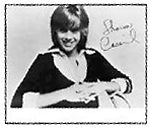THE WORLD IS FULL of folks who once whiled away biology class daydreaming of musical stardom, yet now must hold down a 9-to-5 job to pay their cable bill and catch an hour of MTV now and then. But not Eric Johnson of the Fruit Bats. His fantasies ran in the opposite direction.
“When I was a little kid, I wanted to become a zoologist,” says Johnson, 26, from his Chicago home. Although he expresses mixed feelings about zoos today, as a youngster, they were his favorite destination, bar none. “If you had asked, ‘Do you want to go to Disney World for 10 days or the zoo for 10 minutes?’ I would have picked the zoo. I was obsessed.”
Alas, Johnson’s career aspirations didn’t quite come to pass. “I was not a school person,” he admits. Much as he loved animals, the requisite hours of study held no allure. “But you don’t have to be a school person to make rock music.”
Not that the two fields are mutually exclusive; there’s more potential for overlap than just getting stoned while listening to Pink Floyd’s Animals. Like the songs of Sparklehorse’s Mark Linkous, the Fruit Bats’ catalog is teeming with fauna. On the group’s recent Sub Pop release, Mouthfuls, you’ll catch references to “leviathans down in the abyss” and shorn sheep, while its predecessor, 2001’s Echolocation, featured song titles including “Buffalo & Deer” and “A Dodo Egg.”
The Fruit Bats began life in 1999 as a solo side project to Johnson’s earlier band, I Rowboat. Eventually, Tim Rutili and Ben Massarella of Califone, with whom multi-instrumentalist Johnson played for a spell, offered to release a Fruit Bats full-length via their Perishable Records imprint. The well-received Echolocation helped secure the group shows with Modest Mouse, the Shins, and Gorky’s Zygotic Mynci. But its 12 originals erred in favor of an artier, folk-influenced sound. This time out, Johnsonaided by new bandmate Gillian Lisée (formerly of Orso)made a deliberate effort to concentrate on pop structures and arrangements that would adapt easily to live performance.
While the Americana-infused songs of Mouthfuls are more immediately accessible than the Fruit Bats’ earlier work, the production (overseen by the band and cohort Brian Deck, who has also worked with Modest Mouse and Red Red Meat) is still surprisingly ambitious, recalling, at various points, artists as grandiose as Electric Light Orchestra (“The Little Acorn”) and Phil Spector (the final bars of “The Magic Hour”). Not that Johnson and company sat down at the mixing board and deliberately tried to re-create Pet Sounds or any other multitrack masterpiece.
“Unless you have an infinite amount of time in the studiowhich means moneynothing ever comes out exactly the way you planned it, which is a good thing,” he says. “If I say, ‘I want this to sound like Supertramp,’ I can make an attempt to do that . . . and, hopefully, I won’t get it exactly right, so it sounds original.”
“That’s why the Rolling Stones and the Beatles are great,” Johnson adds. “They were just naive enough to try [but] not be able to sound like Muddy Waters.”
UNLIKE MICK AND KEITH, Johnson did not sit around absorbing old blues and R&B records as a youth in the western suburbs of Chicago. “My first favorite band was either Boston or Queen, and both of those bands have had a huge effect on my music,” he reveals. But fans shouldn’t panicJohnson doesn’t aspire to rewrite “More Than a Feeling” or “Bohemian Rhapsodyit’s more the grandiloquent vibe he’s after. “[That music is] kind of epic, and I’ve enjoyed epic music of all types from the onset.” That pantheon also includes Neil Young, the Velvet Underground, the Grateful Dead, Harry Nilsson, and Roy Harper.
Oh, that earlier claim about not being “a school person” is no longer quite true. When he isn’t on the road, Johnson shares his love of music via a gig at Chicago’s Old Town School of Folk Music, where he not only teaches basic banjo and guitar but also seminars on topics like Eccentrics of Rock and History of Punk. “I did a couple specialty classes, tooone on the Velvet Underground and another on the Clash.” And he gets paid to do this? “Oh, yeah. It’s a pretty cool job.”
Today, Johnson’s life has more in common with Dr. John and Dr. Hook than Doctor Doolittle, but he still loves animals. Well, most animals. Don’t expect to find any ditties about the Norway rat on any upcoming Fruit Bats CD. Although the Windy City has reduced its rodent population from the 6 million critters running rampant in 1979 to a small fraction of that number, Johnson still takes exception to Chicago’s furry vermin. “I love it here,” he concludes, “but there’s a lot of rats.”






